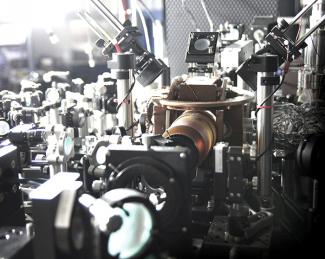The Regal group recently completed a nifty feat that had never been done before: The researchers grabbed onto a single trapped rubidium atom (87Rb) and placed it in its quantum ground state. This experiment has identified an important source of cold atoms that can be arbitrarily manipulated for investigations of quantum simulations and quantum logic gates in future high-speed computers.
Here’s how graduate students Adam Kaufman and Brian Lester and Fellow Cindy Regal did it: First, the researchers captured a gas containing roughly 1 million 87Rb atoms. Second, they illuminated the cloud with a very tightly focused beam of light, creating a tiny micron-sized trap. This trap is called an optical tweezer. From the cloud of atoms, about 10 atoms are loaded into the tweezer. However, when light is applied, the trapped atoms repeatedly collide in the tiny trap, forming molecules. These molecules are subsequently lost from the trap.
About half the time, nothing is left in the tweezer because there was an even number of atoms to start with, and all the atoms escaped as molecules. The other half of the time, however, there was an odd number of atoms at the beginning. In this case, a single atom was left in the tiny trap. The researchers could “see” this atom inside the optical tweezer. At this point, they were ready for the final step: cooling this atom to its quantum ground state.
To further cool the atom, the researchers first used two lasers to lower the energy of the atom by one quantum (of motion), while also flipping its spin. Second, they shined another laser on the atom, which caused the spin to flip back, while leaving the atom in its new lower energy state. Cooling the atom to its quantum ground state (in all three dimensions) simply required repeating this two-step cycle 75 times.
The optical tweezer was a key ingredient in the cooling process. During the second step in which a laser flips the atom back into its original spin state, for example, the tweezer holds the atom tightly in place. This confinement makes it far less likely that the laser will accidentally excite the atom to a higher energy state, which would prevent the cooling from happening.
After the cooling, the researchers were able to tell when the atom had reached its quantum ground state. When the atom is in the ground state, it has no additional lower-energy states. It’s no longer possible for the atom to lower its energy of motion. The researchers confirmed that the atom had reached its quantum ground state when they tried one more time to lower the energy and the atom failed to flip its spin.
Now that the Regal group has figured out how to prepare single neutral atoms in their quantum ground state, a whole new field of research is opening up. For instance, these cold atoms may be placed near complicated optical patterns near surfaces, e.g., on a chip destined for a quantum computer. This placement should be possible because neutral atoms do not usually interact with their surroundings as do charged ions, which were the first single particles to be cooled and trapped.
Currently, Kaufman and his colleagues are working on trapping multiple single 87Rb atoms in optical tweezers to see if it is possible to observe quantum tunneling between different tweezers after each of their single atoms is cooled to its quantum ground state. Quantum tunneling is a phenomenon where a tiny particle, such as an atom or an electron, tunnels through an energy barrier that it would not be able to surmount according to the laws of classical physics.— Julie Phillips




